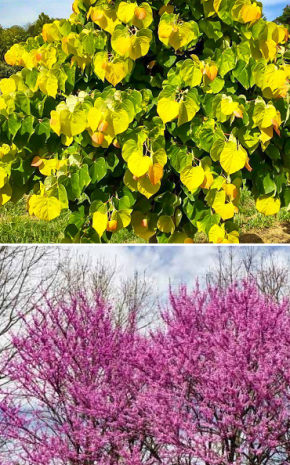Redbud trees are lovely deciduous trees that welcome spring with a spectacular display of color, unlike any other tree. Redbuds are well-known for the small, vivid blooms that appear to explode from the buds of the plant when spring arrives. Flowers on redbud trees open up long before their leaves emerge from winter dormancy. These trees feature heart-shaped leaves that shine in the sunlight and are a constant focus point.
Rising Sun was discovered in 2006 by Cindy Jackson and Ray of Jackson Nursery, who previously discovered Ragin’ Red Dogwood and Blue Ray Kousa. On the other hand, the native habitat of the Eastern Redbud extends from New Jersey to the northern tip of Florida, west to the state of Missouri, and Texas and northern Mexico. Trees mostly grow in a range of soils on both upland and disturbed sites.
Rising Sun Redbud vs. Eastern Redbud Characteristics
The Rising Sun Redbud puts up a fantastic display. Orange is the color of newly emerged leaves, which, as they mature, change to peach, then bright yellow, then chartreuse, and finally a dark green color. The exceptional color doesn’t stop there, either. This fast-growing, short-lived tree can reach a height of eight to twelve feet. It is therefore ideal for almost any location in the landscape. The Eastern Redbud stands out from the crowd in the early spring because it blooms before most trees’ leaves do. The tree is not suitable for use as a supply of lumber due to its tiny size and irregular shape. This tree is widely planted and appreciated mostly as an ornamental.
Rising Sun Redbud vs. Eastern Redbud Growth Rate
Rising Sun redbuds are beautifully colored. It features yellow leaves in the fall and green, orange, and yellow foliage in the spring and summer. The Rising Sun Redbud, like most trees, develops rapidly while young, then slows down around years ten to fifteen. Eastern Redbuds, on the contrary, are garden trees that mature at 20-30 feet tall and 25-35 feet wide. It grows at a moderate rate, increasing in height by thirteen to twenty-four inches every year. It can reach a height of seven to ten feet in approximately five to six years under optimal conditions. It grows best in zones 4–8.
Rising Sun Redbud vs. Eastern Redbud Care
Redbud trees are versatile, easy-to-grow trees that thrive in both acidic and alkaline soil. After being established, they can tolerate dry conditions well even in full sunlight or partial shade.
Rising Sun Redbuds just like other Redbuds can thrive in full and partial sun. Make sure the tree receives a minimum of six hours of sunlight once planted to give the best appearance, as too much shade can diminish the spectrum of color. It is best to plant this tree in a location that receives full sunlight. It is also important to fertilize correctly. Pruning of this tree is mostly recommended when it has finished blooming in early summer. Branches that rub against or cross over one another are to be removed first, along with any big lower branches. Remove branches near the trunk without stubs.
In contrast, the eastern redbud can thrive in zones four to eight. This cultivar of the Redbud tree is also drought tolerant. When the soil is dry to a depth of two to three inches, Eastern redbuds typically require watering once per week. Make sure to place this plant carefully because it is not good to transplant this tree. Avoid planting this eastern redbud tree in an area where it is subjected to strong winds because its branches can easily be broken.



